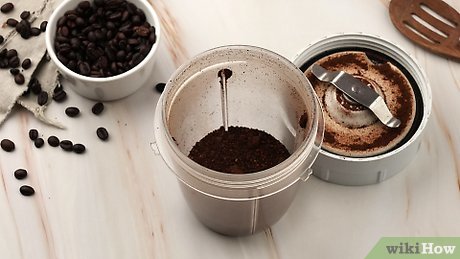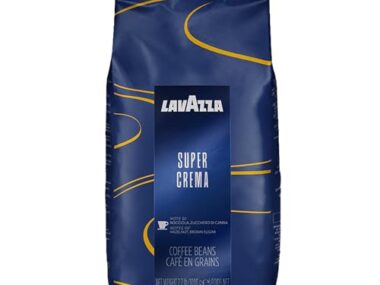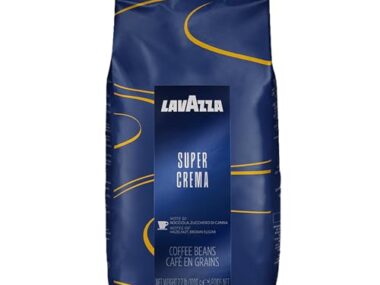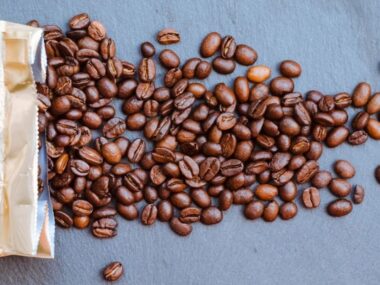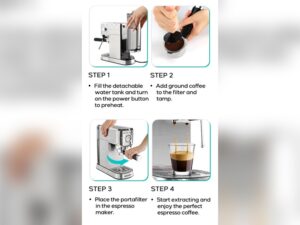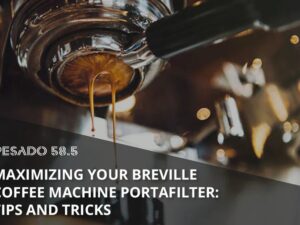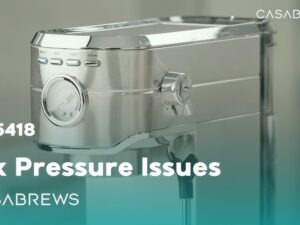Grinding coffee beans without a grinder is possible with simple household items. If you’re wondering how to grind coffee beans without a grinder, this guide shows easy methods for a fine, fresh brew.
Many coffee lovers find themselves without a grinder at some point. Freshly ground coffee always tastes better, but what can you do if your grinder breaks or you don’t have one? Don’t worry; there are several effective methods to grind coffee beans using tools you likely already have in your kitchen.
This post will guide you through these methods, ensuring you can still enjoy your perfect cup of coffee. Let’s explore how to grind those beans without a grinder, so you never have to miss out on that fresh coffee aroma and taste.

Credit: www.wikihow.com
Alternative Methods
Grinding coffee beans without a grinder might seem impossible, but there are alternative methods that can help you achieve your desired coffee grounds. These methods are simple and use common kitchen tools. Let’s explore two effective ways to grind coffee beans without a grinder.
Using A Mortar And Pestle
A mortar and pestle is a traditional tool often used to grind spices, but it can also be used for coffee beans. This method allows you to control the coarseness of the grind. Here are the steps to follow:
- Place a small amount of coffee beans into the mortar. Do not overfill.
- Use the pestle to crush the beans with a twisting motion.
- Continue grinding until you reach your desired grind size.
Grinding coffee beans with a mortar and pestle offers several benefits:
- Control: You can achieve a fine, medium, or coarse grind.
- Freshness: Grinding just before brewing ensures fresh coffee.
- Simplicity: No electricity or complex machinery needed.
Though it requires some effort, using a mortar and pestle is an effective and rewarding way to grind coffee beans.
Employing A Rolling Pin
A rolling pin is another household item that can be used to grind coffee beans. This method is straightforward and effective. Follow these steps:
- Place your coffee beans in a plastic bag or between two sheets of parchment paper.
- Use the rolling pin to press down on the beans, crushing them.
- Roll the pin back and forth to grind the beans to your desired consistency.
Using a rolling pin has its advantages:
- Availability: Most kitchens have a rolling pin.
- Cost-effective: No need to purchase special equipment.
- Efficiency: This method can grind a larger amount of beans at once.
To make this process easier, ensure the surface is stable and the beans are spread evenly. This method might take a bit of effort, but it provides a good alternative to using a grinder.
Blender Techniques
Grinding coffee beans without a grinder might seem challenging, but using a blender is a practical solution. The high-speed blades of a blender can crush coffee beans effectively, giving you a decent grind. Here, we will explore some blender techniques to achieve a perfect grind and ensure your coffee remains flavorful and fresh.
Pulse Blending
Pulse blending is an excellent method for grinding coffee beans using a blender. It involves short, quick bursts of blending. This helps to control the grind size and prevent the beans from heating up.
Here’s how to do it:
- Fill the Blender: Add a small amount of coffee beans to the blender. Filling it halfway ensures better control.
- Use the Pulse Setting: Set your blender to the pulse setting. Pulse for 3-5 seconds at a time.
- Check the Grind: After a few pulses, check the grind consistency. Repeat the process if needed until you reach the desired grind size.
Pulse blending allows you to achieve various grind sizes:
| Grind Size | Pulse Duration | Use |
|---|---|---|
| Coarse | 3-5 seconds | French Press |
| Medium | 5-10 seconds | Drip Coffee Maker |
| Fine | 10-15 seconds | Espresso Machine |
Avoiding Overheating
Overheating can affect the flavor of your coffee. It’s crucial to avoid this during the grinding process. Here’s how to prevent overheating:
- Short Pulses: Use short pulses of 3-5 seconds. This keeps the beans from overheating.
- Rest Between Pulses: Allow the blender to rest for a few seconds between pulses. This ensures the motor and beans cool down.
- Small Batches: Grind in small batches to minimize heat buildup. Overloading the blender can generate excess heat.
Follow these tips to keep your coffee beans from overheating:
- Monitor Temperature: Feel the blender jar. If it gets warm, let it cool before continuing.
- Use Ice Packs: Place ice packs around the blender jar to keep it cool.
- Grind Slowly: Take your time. Rushing can cause the beans to heat up quickly.
By avoiding overheating, you preserve the coffee’s natural oils and flavors, resulting in a better-tasting brew.
Food Processor Tips
Grinding coffee beans without a grinder can seem challenging. Luckily, a food processor can help. It is a handy kitchen tool that can grind your coffee beans effectively. With a few tips, you can achieve a consistent grind that will make your coffee taste great. Here are some essential tips for using a food processor to grind coffee beans.
Optimal Settings
Setting your food processor correctly is crucial for grinding coffee beans. Here are some tips to get the best results:
- Pulse Setting: Use the pulse setting instead of a continuous grind. This prevents overheating and ensures a more consistent grind.
- Short Bursts: Grind in short bursts of 3-5 seconds. Shake the processor slightly between bursts to redistribute the beans.
- Consistency: Check the grind size frequently. Aim for a coarse or medium grind for optimal flavor.
Using these settings, you can avoid over-grinding. Over-grinding can create fine particles that can make your coffee taste bitter. Here is a table to help you understand the different grind sizes and their uses:
| Grind Size | Use |
|---|---|
| Coarse | French Press |
| Medium | Drip Coffee Maker |
| Fine | Espresso |
Adjust the settings based on your preference and the type of coffee maker you use. Remember, it is better to under-grind slightly than to over-grind.
Batch Grinding
Grinding in batches can save time. It also ensures a consistent grind. Here’s how to do it:
- Small Batches: Grind a small amount of coffee beans at a time. This prevents the processor from overloading.
- Shake Between Batches: Shake the processor between each batch. This helps mix the beans and achieve a uniform grind.
- Store Properly: Store ground coffee in an airtight container. This keeps it fresh and flavorful.
Grinding in batches ensures each batch is consistent. Here is a simple guide to help you understand batch sizes:
| Batch Size | Number of Cups |
|---|---|
| 50 grams | 5-6 cups |
| 100 grams | 10-12 cups |
By following these tips, you can grind coffee beans without a grinder. Your food processor will help you achieve a consistent grind. Enjoy your fresh coffee every morning.

Credit: coffeeroastco.com
Using A Hammer
Grind coffee beans without a grinder using a hammer. This method is simple and effective. The hammer is a common household tool. It can break down coffee beans to the desired size. Using a hammer requires some care. Safety is important. Also, there are steps to get the best results.
Safety Precautions
When using a hammer, safety comes first. Follow these tips to stay safe:
- Protect your hands: Wear gloves to avoid injury. Hammers can slip.
- Use a sturdy surface: Place the coffee beans on a cutting board. Avoid fragile surfaces.
- Cover the beans: Use a plastic bag or kitchen towel. This keeps beans from scattering.
- Control your strength: Gentle taps work best. Avoid strong hits. They can damage beans and tools.
Here is a table for quick safety tips:
| Action | Reason |
|---|---|
| Wear gloves | Protects your hands |
| Use a cutting board | Prevents damage to surfaces |
| Cover beans | Keeps beans contained |
| Gentle taps | Avoids bean and tool damage |
Effective Technique
Grinding coffee beans with a hammer needs the right technique. Follow these steps:
- Prepare the beans: Place the desired amount of beans in a plastic bag. Seal it to avoid spills.
- Set up your surface: Lay the plastic bag on a cutting board. Ensure it is flat and stable.
- Position the hammer: Hold the hammer firmly. Aim at the center of the bag.
- Start tapping: Use gentle taps. Apply even pressure. Move the hammer around for uniform grinding.
- Check the grind: Open the bag to check the size. Repeat tapping if needed.
Here are some tips for an even grind:
- Rotate the bag: Turn the bag occasionally. This ensures all beans are crushed.
- Adjust pressure: Increase pressure if beans are too large. Decrease if too fine.
- Inspect frequently: Check the grind size often. This helps achieve the perfect consistency.
Grinding coffee beans with a hammer is easy. Follow these steps. Enjoy fresh coffee without a grinder.
Coffee In A Bag
Introduction paragraph about How to Grind Coffee Beans Without a Grinder and Coffee in a Bag…
Grinding coffee beans without a grinder may seem challenging, but it’s quite possible with a few household items. One effective and straightforward method is using a bag. This method is simple and doesn’t require special tools. Plus, it’s a great way to achieve a consistent grind, which is essential for a perfect cup of coffee.
Choosing The Right Bag
Choosing the right bag is crucial for this method. A sturdy and durable bag ensures the beans stay contained while you crush them. Here are some options:
- Plastic Freezer Bags: These bags are thick and durable, making them perfect for this task. They can withstand the pressure and won’t easily tear.
- Ziploc Bags: Another good option. Ensure you use double-layered ones for added strength.
- Cloth Bags: If you prefer a more eco-friendly option, a thick cloth bag works well. Just make sure it’s tightly woven to prevent beans from escaping.
Inspect the bag for any holes or weak spots. A damaged bag can lead to a mess and uneven grinding. Here is a quick comparison table for your reference:
| Bag Type | Durability | Eco-Friendly |
|---|---|---|
| Plastic Freezer Bag | High | No |
| Ziploc Bag | Medium | No |
| Cloth Bag | Medium | Yes |
Crushing Method
Once you have selected the right bag, it’s time to crush the coffee beans. Follow these steps:
- Fill the Bag: Place a measured amount of coffee beans inside the bag. Seal it tightly to avoid any spills.
- Prepare the Surface: Lay the bag flat on a sturdy surface like a cutting board or countertop. This will provide a solid base for crushing.
- Use a Rolling Pin: Gently roll over the bag with a rolling pin. Apply even pressure to crack the beans. Roll back and forth until you achieve the desired grind size.
- Check Consistency: Open the bag occasionally to check the grind size. Continue rolling if needed, ensuring uniformity.
For a finer grind, repeat the process several times. For a coarser grind, apply less pressure. This method is simple yet effective. It allows you to control the grind size based on your brewing method.
Remember to clean the surface and tools after crushing to avoid any mess. Enjoy your freshly ground coffee!
Electric Mixer Hacks
Grinding coffee beans without a grinder might seem challenging, but with a bit of creativity, you can get the job done. One effective method is using an electric mixer. Many people overlook this household appliance, but it can be a lifesaver for coffee enthusiasts. Let’s explore some electric mixer hacks that will help you grind your coffee beans to perfection.
Using The Whisk Attachment
While it may seem unconventional, the whisk attachment of your electric mixer can be quite effective. Here’s how to use it:
First, ensure that your mixer and whisk attachment are clean and dry. You don’t want any residual flavors contaminating your coffee beans. Now, follow these steps:
- Place a small number of coffee beans into a deep mixing bowl.
- Attach the whisk to your mixer.
- Start the mixer on a low setting to avoid beans flying out of the bowl.
- Gradually increase the speed as the beans begin to break down.
- Pause the mixer occasionally to check the consistency of the grind.
- Continue until you achieve the desired fineness.
This method works best with small amounts of beans. If you need a larger quantity, repeat the process in batches. Be patient and take your time. Rushing can lead to uneven grinds.
Adjusting Speed
The speed settings on your electric mixer are crucial for achieving the perfect grind. Let’s break down how to use them effectively:
Start with a low speed. This helps in breaking down the beans without creating a mess. Gradually increase the speed as the beans become smaller. Here’s a simple guide:
| Speed Setting | Purpose |
|---|---|
| Low | Initial breakdown of whole beans |
| Medium | Grinding beans to a coarse texture |
| High | Achieving a fine grind |
Be mindful of the heat generated by the mixer. Prolonged use on high speed can warm the beans, affecting their flavor. Here are some tips to avoid this:
- Use short bursts instead of continuous mixing.
- Allow the mixer to cool down between bursts.
- Monitor the temperature of the beans by touch.
Following these steps ensures that your coffee beans are ground to perfection without losing their rich flavors.
Choosing The Right Grind Size
Grinding coffee beans without a grinder can seem like a daunting task. But knowing how to choose the right grind size can make a significant difference in your coffee experience. The grind size affects the brewing time, flavor, and overall quality of your coffee. Whether you use a blender, a rolling pin, or a mortar and pestle, understanding coarse and fine grinds will help you achieve the perfect cup.
Coarse Vs. Fine
A coarse grind has larger, chunkier pieces of coffee beans. This type of grind is ideal for methods like French press and cold brew. Coarser grinds require longer brewing times to extract flavors properly.
- French Press: Coarse grind ensures the coffee grounds do not pass through the mesh filter.
- Cold Brew: Coarse grind allows for slow extraction, resulting in a smooth flavor.
On the other hand, a fine grind has smaller, powdery particles. This grind is suitable for espresso and Aeropress. Finer grinds require shorter brewing times.
- Espresso: Fine grind ensures quick extraction, producing a rich and intense flavor.
- Aeropress: Fine grind allows for a fast brewing process, resulting in a strong cup.
| Grind Size | Brewing Method |
|---|---|
| Coarse | French Press, Cold Brew |
| Fine | Espresso, Aeropress |
Impact On Flavor
The grind size has a direct impact on the flavor of your coffee. A coarse grind tends to produce a milder, less intense flavor. This is because the larger particles have less surface area, leading to slower extraction.
A fine grind, on the other hand, results in a stronger, more robust flavor. The smaller particles have more surface area, allowing for quicker extraction and a more intense taste.
- Coarse Grind: Less surface area, slower extraction, milder flavor.
- Fine Grind: More surface area, quicker extraction, stronger flavor.
Brewing time also plays a crucial role. A longer brewing time with a coarse grind can balance the flavor, while a short brewing time with a fine grind can produce a bold and rich cup.
Understanding the relationship between grind size and flavor can help you achieve the perfect balance. Whether you prefer a mild or strong cup, adjusting the grind size can make all the difference.

Credit: coffeeroastco.com
Storage Tips For Ground Coffee
Grinding coffee beans without a grinder can be a fun and creative process. But once you’ve got your ground coffee, storing it properly is crucial. Proper storage keeps your coffee fresh and flavorful. Here are some essential storage tips for your ground coffee.
Avoiding Staleness
Staleness is the enemy of fresh coffee. To avoid it, you need to understand what causes coffee to go stale. Oxygen, moisture, light, and heat are the main culprits. Here are some tips to keep staleness at bay:
- Keep it airtight: Exposure to air can cause coffee to lose its flavor. Use airtight containers to store your ground coffee.
- Store in a cool, dark place: Light and heat can degrade coffee quality. Keep your container in a pantry or cupboard.
- Avoid moisture: Moisture can make coffee go stale quickly. Ensure your container is dry before adding coffee.
Consider using vacuum-sealed bags or containers with one-way valves to let out carbon dioxide without letting air in. This can significantly extend the freshness of your ground coffee.
Best Containers
The choice of container plays a big role in maintaining the freshness of your ground coffee. Here are some of the best options:
| Container Type | Features | Pros | Cons |
|---|---|---|---|
| Glass Jar | Airtight lid | Non-reactive, easy to clean | Allows light in |
| Stainless Steel Canister | Airtight, opaque | Blocks light, durable | Heavier than glass |
| Ceramic Container | Airtight, opaque | Blocks light, non-reactive | Fragile |
| Vacuum-Sealed Bags | One-way valve | Prevents air exposure | Single-use, plastic |
Each container type has its advantages and disadvantages. Glass jars are popular but allow light in. Stainless steel and ceramic containers block light and are durable. Vacuum-sealed bags are excellent for preventing air exposure but are often single-use.
Choose a container that fits your needs and helps keep your coffee fresh for longer. Remember, the goal is to reduce exposure to air, light, heat, and moisture.
Frequently Asked Questions
What Is The Best Way To Grind Coffee Beans Without A Grinder?
Use a blender or food processor to grind coffee beans. Pulse in short bursts for best results. A rolling pin, hammer, or mortar and pestle can also work for a coarse grind.
What Can I Use If I Don’t Have A Coffee Grinder?
Use a blender or food processor to grind coffee beans. A rolling pin or mortar and pestle can also work.
How Long Can You Grind Coffee Beans In A Food Processor?
Grind coffee beans in a food processor for 20-30 seconds. Check the consistency and repeat if needed for finer grounds.
Is It Safe To Grind Coffee Beans In A Blender?
Yes, it is safe to grind coffee beans in a blender. Use short pulses to avoid overheating. Adjust the grind size by blending longer or shorter. Ensure the blender is clean before use.
Conclusion
Grinding coffee beans without a grinder is easy with simple tools. Use a blender, rolling pin, or even a hammer. Each method works well for a fresh cup. Try different ways to see what you like best. Freshly ground coffee tastes better and smells amazing.
Enjoy the process and your perfect cup of coffee. Happy brewing!
